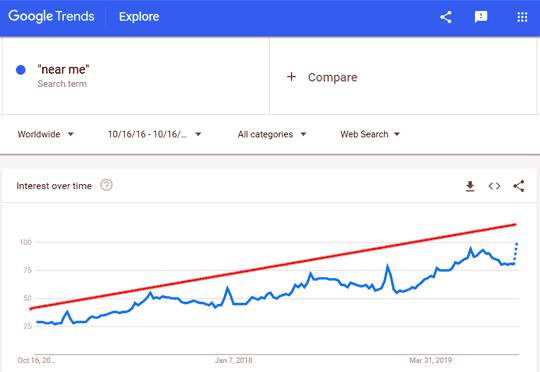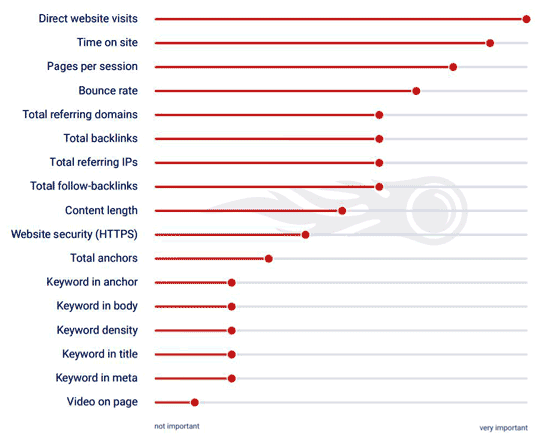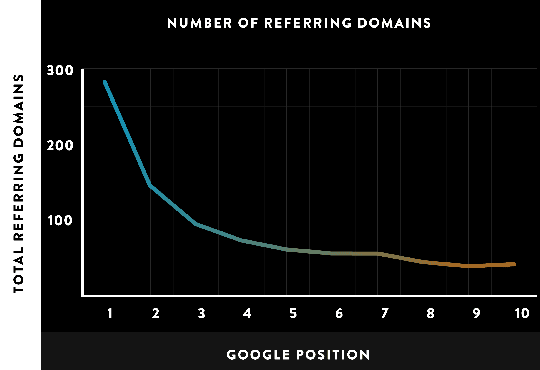Organic search is an ever-evolving landscape that makes SEO a constant game of adaptation. It’s easy to get stuck in the weeds, constantly obsessing about things like link building and metadata. But it’s also vital to take a step back and look at the bigger picture of what’s happening in the world of search.
Taking a moment to explore the latest research and data is one of the best ways to stay current and cultivate new ideas. In some cases, a study might reshape how you think about SEO. In an effort to go beyond the overly-discussed SERP data and click-through insights, here are 5 search studies that might do just that.
1. Local Searches Containing “Near Me” Have Increased 219% in the Past 3 Years
According to search popularity data from Google Trends, in the last three years local searches containing “near me” have risen 212.9% from 2016 to 2019 (worldwide).
This data is no secret to the SEO community. But beyond emphasizing how popular “near me” searches have gotten over the last few years, there are several ways businesses can better position themselves in Google Search.
This search data offers a wealth of strategic insight in more ways than one. A few specific SEO opportunities with the rise in “near me” include:
- Integrating LocalBusiness schema markup on your site can help improve visibility for “near me” search queries.
- Claiming and optimizing a business’s Google My Business listing is critical, as the local pack (which is comprised of GMB listings) is most commonly shown with these types of searches.
- Having a mobile-friendly site is absolutely essential to be competitive for “near me” searches. To assess this, try Google’s Mobile-friendly Test Tool.
2. Direct Traffic is the Most Influential Ranking Factor
Despite content and links being the hottest topics in the SEO community, the most influential ranking factor is often overlooked. That is, direct website traffic. Backed by a recent study by SEMrush, Google places direct traffic as the dominant ranking factor in search.
To be clear, direct traffic is defined by users who visit a site directly from the browser bar without searching Google or clicking a link on another site. Similar to links, Google views this factor as a powerful sign of credibility, trust, and authority.
This emphasizes the importance of having a diversified marketing strategy beyond Google search. SEO in itself, especially for a new domain, can take several months before it starts earning visibility and traffic.
Consider optimizing for this ranking factor by expanding your marketing mix:
- Start building and organizing an email marketing list, and creatively leverage this list to promote sales, content, or other value you can provide.
- Use social media platforms like Facebook, LinkedIn, and Twitter for networking and building relationships; growing visibility and followers; and marketing your content.
- Start blogging (or vlogging), including guest blogging. This helps bridge the gap with what you share on social media and email. Blogging also supports your site’s SEO, as blog posts can generate organic traffic and links from other sites.
- Consider joining your area’s chamber of commerce (the referral link alone is sometimes worth the membership fee).
- Sponsor local events or even consider charitable donations.
3. More Backlinks Correlates to Higher Rankings
To help paint a broader picture behind what influences search rankings, Backlinko set out to see whether or not Google still uses the sheer number of backlinks as a ranking signal. The study claims that “the number of domains linking to a page correlated with rankings more than any other factor.”
So although SEMrush found direct traffic to be the most influential ranking factor, link signals still play a powerful role in determining a site’s search rankings. Before we start debating between links and direct traffic, it’s important to dissect what Backlinko says in that sentence.
“Number of domains” does not mean number of links. This metric points to the number of different websites (often called “referring sources”) in which a site is earning its links. In other words, Backlinko is staking this claim based on link diversity.
A few things to help cultivate greater link diversity are:
- Take advantage of online directory listings, whether local or industry-related.
- Have a social media presence where it makes sense.
- Submit your business to Local Data Aggregators such as Infogroup, Neustar Localeze, Factual and Acxiom. For instance BrightLocal is a great tool for this.
- Become a guest blogger on other publishing platforms.
- Create link worthy content on your own site (easier said than done).
4. 76% of Local Searchers Will Visit a Business Within 24 Hours
Yes, you read that right: 76% of people who use their smartphone to conduct a local search (i.e. “shoes downtown Atlanta”) will visit a business within 24 hours.
If that isn’t enough to magnify the importance of local SEO for brick and mortars, then consider that the same research from Think by Google found that 28% of those local search queries result in a store purchase.
This underscores why SEO is more than just growing search visibility and traffic. It’s also about mapping the customer journey and leveraging those insights to instruct decisions about content, offers, and other strategies.
If you support a brick and mortar, then this data applies to you. Make sure to cover the basics like:
- Making it easy for people to contact the business via email or form submission AND phone.
- Clearly having store hours available, as well as up-to-date holiday hours. This includes GMB, Facebook, and other listings where users might be checking to see when you’re open.
- Having web pages for the products, or at the very least the brands, in which the business carries.
- Promoting discounts and specials on the site. A rotating banner is an accommodating feature for this.
5. By 2020, Over Half of All Searches Will Be Voice-based
With smart speakers becoming integral technology for homes and living spaces, voice search is rising rapidly. So much so that voice search predictions by ComScore are on track to become a reality. By the year 2020, it’s expected that more than 50% of all online searches will be performed with voice search.
From a strategic perspective, supportive data from seoClarity points to interesting insights for SEO and content marketing strategists. Based on the data below, 20% of all voice search queries are generated by a combination of only 25 keywords.
For voice search optimization, it’s clear that tailoring content that speaks to certain questions can add value to a site’s SEO. Naturally, the growing prevalence of voice search runs parallel with more and more long-tail queries.
It’s no secret that developing a voice-search-friendly content strategy has become integral to tapping into this growing trend. It’s also why you see more and more bloggers positioning their content as questions.
Instead of “5 tips to remove gum from your shoes” consider restructuring the titled to read “how to remove gum from your shoes in 5 easy steps”. The “how” being the SEO-friendly trigger word in this example.
Final Thoughts
So if you’re still obsessing about link building and metadata, by now, hopefully you’re thinking about things like content strategy, voice search, technical SEO, networking, and building brand awareness. These days, so much of SEO is focused on humans and providing a seamless, value-driven user experience.
[Images – Main photo by Evgeni Tcherkasski on Unsplash; Sandals photo by LumenSoft Technologies on Unsplash; other images, graphics or videos are from their respective websites and/or social platforms]
Jennica Hill is a content strategist at Captivate Search Marketing, a Search First® digital marketing agency based in Atlanta, Georgia.







